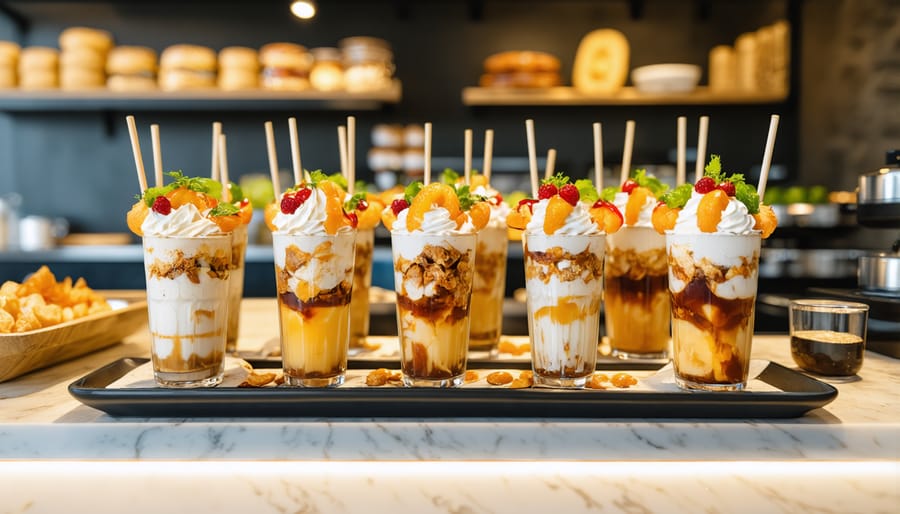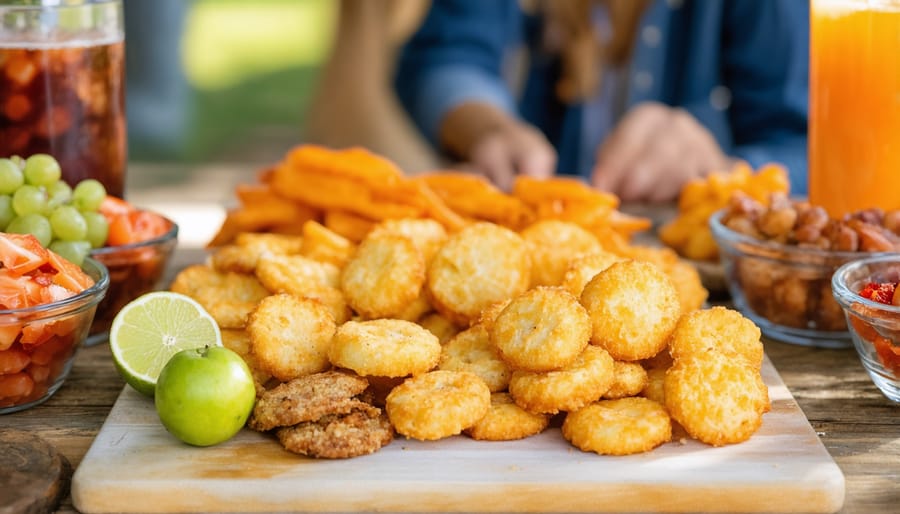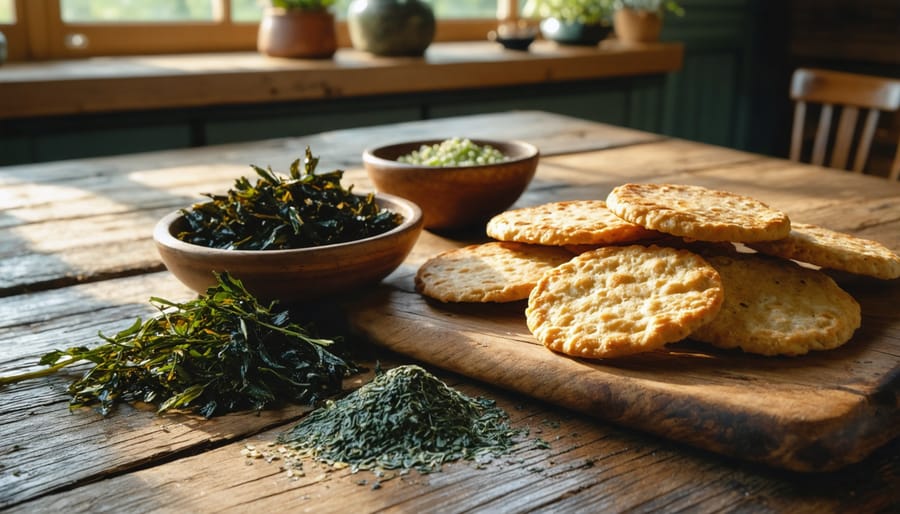Discover the authentic flavors of Nova Scotia’s snack culture by exploring local markets for traditional treats like oatcakes, dulse, and seaweed snacks. Engage with artisans at community events to taste homemade specialties and gain insight into their preparation. Visit local shops and online platforms for diverse snack options such as collations Brossard, blending Nova Scotia flair with international sweets. Connect with Nova Scotians to share and learn about family recipes that have been passed down through generations, enriching the regional culinary tapestry.
A Historical Bite: Traditional Snacks
Famous Historical Snacks
Oatcakes, fish cakes, and dulse are staple snacks deeply woven into Nova Scotia’s cultural heritage. Oatcakes, with their roots tracing back to Scottish immigrants, are a simple yet beloved treat, often accompanying tea time with their hearty, slightly sweet flavor. These rustic biscuits symbolize Nova Scotian hospitality and a connection to the province’s Scottish ancestry. Fish cakes, traditionally made from salt cod and potatoes, are another culinary gem that reflects the region’s rich fishing history. Once a practical way to utilize the abundant local catch, these savory cakes now serve as a reminder of the community’s reliance on and respect for the sea. Dulse, a red seaweed harvested along the Atlantic coast, has been a source of nutrition and flavor for generations. Often eaten dried as a salty snack or added to dishes for its umami punch, dulse underscores the storied relationship between Nova Scotians and the marine environment. Together, these snacks offer a delicious glimpse into the province’s traditions and the harmony between its people and landscape.

Influence of Indigenous and Settlers’ Food
Nova Scotia’s snack culture is a delicious tapestry woven from the rich culinary traditions of Indigenous peoples and settlers. The Mi’kmaq, the region’s Indigenous community, have long harvested the bounty of the land and sea, introducing ingredients like wild berries, maple syrup, and seafood. These elements laid the foundation for many native dishes that continue to influence local snacks. With the arrival of European settlers, particularly the Scots, Irish, and Acadians, new flavors and techniques were introduced, such as the use of grains and dairy products. The blending of these diverse culinary practices led to the creation of unique Nova Scotian treats like oatcakes and rappie pie. Today, markets and festivals across the province celebrate this rich heritage by highlighting snacks that tell the story of Nova Scotia’s multicultural roots. More than just food, these snacks are a testament to the enduring legacy and harmonious exchange between the region’s Indigenous communities and settlers.
Modern Twist on Traditional Favorites
Fusion and Innovation
Nova Scotia’s snack scene is evolving as local artisans and chefs ingeniously blend traditional flavors with modern culinary techniques. Consider the dulse seaweed-infused chocolate truffles or the classic oatcake reimagined with a touch of exotic spices. These innovative snacks preserve the familiar taste of Nova Scotia while adding a contemporary twist. Local breweries are joining the movement by crafting sea-salt inspired ales, and food festivals are showcasing these taste sensations, reflecting a community-driven push towards culinary creativity. Residents and visitors alike are excited to experience these pioneering flavors that honor local heritage while embracing future possibilities.

Local Businesses & Entrepreneurs
Nova Scotia’s snack culture is being redefined by innovative local businesses and creative entrepreneurs who are adding a fresh twist to traditional flavors. In Mahone Bay, the Island Folk Cider House has transformed local apples into delicious cider snacks. Meanwhile, Lunenburg’s Seaweed Co. is revitalizing the seaweed tradition, crafting unique snack blends that have quickly gained popularity. In Halifax, Tidal Salt founders are introducing gourmet hand-harvested salts, enhancing the taste of everyday snacks. These entrepreneurs not only celebrate Nova Scotia’s rich culinary heritage but also boost the local economy, fostering a deeper connection with the community.
Community and Social Aspects of Snacking
Snacks in Community Events
Snacks play a pivotal role in Nova Scotia’s community events, acting as cultural symbols and social connectors. From vibrant summer fairs to cozy winter gatherings, the diverse array of treats reflects the province’s rich culinary heritage. The scent of freshly baked oatcakes, the crunch of dulse with its distinct maritime flavor, and the satisfying bite of locally made pepperoni sticks are familiar comforts for many. These snacks not only sustain but also foster a sense of belonging and shared identity among residents. When attending cultural workshops or neighborhood events, these delights emphasize the communal experience, drawing people together and keeping Nova Scotia’s snack traditions vibrant and alive.
Family Traditions and Gatherings
In Nova Scotia, snacks serve as a cherished element of family traditions and gatherings, offering a sense of comfort and nostalgia. Whether it’s enjoying dulse, a local seaweed delicacy, or indulging in the crunch of kettle chips, these treats bring families together, creating bonds that reflect the region’s communal spirit. At community events, such as local markets and festivals, snacks become a central feature, highlighting shared culinary heritage. During intimate family gatherings, homemade snacks like oatcakes and blueberry grunt celebrate Nova Scotia’s rich agricultural roots. These experiences are often supported by community initiatives that nurture local resources. Whether passing down recipes or exploring modern twists on traditional favorites, snacks remain integral to maintaining familial connections, fostering a sense of belonging and pride among Nova Scotians.
Cultural Influence and Snack Evolution

Global Flavors in Local Bites
Nova Scotia, with its robust cultural mosaic, has embraced a variety of international snacks that resonate with local palates. Among these, imported Japanese mochi ice cream has become a beloved treat, offering a chewy, sweet experience. Similarly, the South Shore’s fondness for spicy flavors has fueled the popularity of Mexican tortilla chips, often paired with locally crafted salsas. Additionally, French macarons, available at local bakeries, have become a favorite for those seeking a delicate, flavorful bite. These imports not only enrich Nova Scotia’s snack culture but also reflect the region’s openness to global culinary influences.
Adapting to Dietary Trends
In recent years, Nova Scotia’s snack culture has evolved significantly, thanks in part to the growing popularity of dietary trends like veganism and gluten-free eating. This shift has encouraged local artisans and businesses to adapt, offering an array of innovative snack options that cater to diverse dietary needs without compromising on taste. From vegan seaweed snacks cultivated from the Atlantic seas to gluten-free oat bars featuring locally sourced ingredients, these offerings reflect a commitment to inclusivity and sustainability. Local markets and community events often showcase these snacks, providing residents and visitors with opportunities to discover and enjoy flavors that align with their dietary preferences. As demand for such options grows, snack producers in Nova Scotia continue to experiment with local ingredients, ensuring that everyone can enjoy the rich culinary traditions of the region while adhering to their dietary choices. This adaptability not only enriches the local food scene but also strengthens community bonds by celebrating shared values of health and environmental consciousness.
Conclusion
Nova Scotia’s snack culture offers a delicious gateway into the province’s rich culinary traditions, reflecting both its historical roots and innovative spirit. From traditional delicacies like dulse to modern favorites like artisanal cheeses and craft beverages, Nova Scotians cherish their local flavors. As the province moves forward, the intertwining of traditional and contemporary tastes is anticipated to grow, driven in part by evolving health trends that influence consumer choices. Local producers continue to adapt, creatively embracing sustainable practices and catering to the demands of a conscientious consumer base. With community-focused events and markets thriving, the snack culture in Nova Scotia not only celebrates its past but looks forward to a vibrant and inclusive future. This evolution promises to strengthen communal ties and reinforce the cultural identity of Nova Scotia, encouraging residents and visitors alike to savor and support the region’s remarkable culinary landscape.

